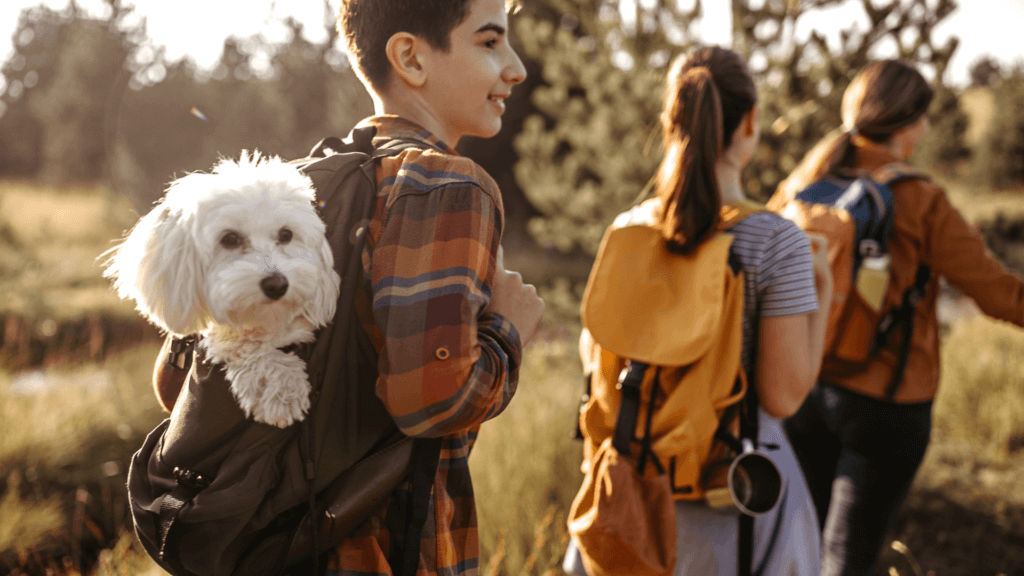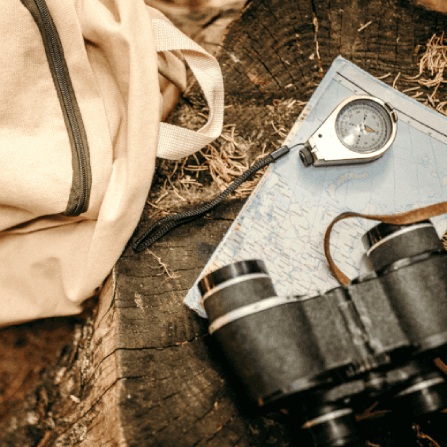Hiking is a wonderful way to get out and see the beautiful countryside of Ireland. It’s also a great way to exercise and care for both your physical and mental health! If you’re new to the trails, it can be tricky knowing what hiking equipment you should take with you though. To help you get out on your first adventure, we have gathered all of the need-to-know information for you. Here, we have curated a checklist for you. So, you can make sure you have everything you need to make sure your hikes are safe and comfortable, so you can enjoy the experience. Let’s dive right in!
What Hiking Equipment Do I Need in My Backpack?
Before heading out into the wilderness, you will need to do some research. This means looking into different hiking areas and trails near you. You should check the difficulty, length and terrain of each trail to make sure it matches your ability and experience. For instance, if you’re a beginner, we recommend starting with shorter trails or sticking to flat ground. Then, you can gradually start on longer, more difficult hikes as your experience builds! Making sure you know the trail will also help guide you in terms of what hiking equipment you will need to take with you. For more information on planning and researching your hikes, you can check out our “Hiking in Ireland: A Beginner’s Guide” blog post!
1. Protective Clothing
First things first, you will need protective clothing. This is important to keep you safe and comfortable during your hiking adventures. But what do you need to bring with you when you’re hitting the trails? Waterproof hiking boots or hiking shoes are a necessity. Hiking in Ireland can be messy business, especially if it has rained in the days leading up to your hike. Specially designed hiking boots and hiking shoes will protect your feet and keep them dry. They’ll also offer ankle support and grip – this is especially important if you’re going uphill or off the track.
You will also need to wear thick hiking socks. Hiking socks cushion your feet and stop painful blisters from forming as your boots rub against the back of your foot as you walk. They’ll also keep your feet dry and less sweaty. We recommend packing a spare pair of socks too – you never know when you’ll need them.
Whether you’re heading out in summer or winter, we recommend always carrying a “Mack in a Sack”. These are waterproof raincoats that are lightweight and roll up to fit in a small bag. Therefore, they don’t take up much space in your hiking backpack. They can be a life-saver when it comes to unexpected rain showers! Macks are light enough to wear during the summer months without getting too hot. However, you should make sure they’re loose enough so you can wear additional warm layers underneath so they’re suitable for hiking during the winter months too.
Hiking Equipment for The Summer Months
If you’re going out for a hike during the summer months, it’s important to protect yourself from the sun. Wide-brimmed hats are ideal as they keep the sun out of your eyes, but they also protect the back of your neck, scalp, forehead, and the tops of your ears – all places that are likely to get burnt. You should always wear SPF 50 (even if it’s not sunny) to make sure your skin is protected from the sun. You should top up your SPF every two hours when out in direct sunlight and reapply immediately after swimming. If it’s hot out and you’re sweating, you should also reapply regularly to ensure maximum protection.
For your summer adventures, we recommend wearing hiking leggings or shorts and avoiding denim at all costs. Denim is heavy and stiff, and jeans will grow uncomfortable after a couple of kilometres (especially if it’s warm out!). In addition, denim will become very heavy when it gets wet so it’s far from ideal in an unexpected rain shower. If you’re opting for shorts, we recommend taking some bug-repellent with you and applying it regularly to any exposed skin. This will protect you from itchy bug bites. You can find bug-repellent sprays in any good hiking equipment or outdoor adventure store.
Hiking Equipment for The Winter Months
To stay warm on the trails during the winter, you’ll need to bring an additional warm layer, such as a fleece or jumper, a hat and gloves. You can also wear a buff or scarf to stay toasty and protect your face from the wind. It’s important to wear layers to stay warm in the colder months. This is because air gets trapped between each layer and heats up, acting as an insulator. Therefore, it’s not a bad idea to invest in some thermals to wear under your t-shirt. Then, you can wear a thick fleece on top.
For winter expeditions, we recommend investing in hiking trousers. These are specially designed for walking and they are lightweight and comfortable but they’ll keep you protected from wind and low temperatures. You could also opt for a waterproof pair of hiking trousers to keep you dry in wet weather.

2. High-Protein Snacks
Hiking is strenuous exercise, especially if you’re going up and down steep hills. So, although not technically “hiking equipment”, snacks are a necessity to keep energy levels up along the way! We recommend packing plenty of high-protein snacks in your backpack so you can snack as you walk. Protein takes longer than carbohydrates to break down in the body. This means that protein is a longer-lasting energy source. Here are some of our favourite snacks for outdoor adventures:
- Trail mix.
- Granola bars.
- Nuts.
- Veggie sticks and hummus.
- Protein bars/balls.
- Fresh/dried fruit.
- Sandwiches and wraps.
- Dates (especially when you stuff them with peanut butter!).
- Tea/coffee to warm you up on chilly days.
3. Water
For a day hike, we recommend taking at least 1.5L to 2L of water with you. You may need to take more if the weather is particularly warm. To make sure you stay hydrated on your hike, you should continuously sip your water as you go along. Make sure you keep your water bottle in the side pocket or at the top of your hiking backpack for easy access. We also recommend using a reusable water bottle as you can take it on all of your trips and it cuts down on single-use plastic!
If you’re on your way to becoming a regular hiker, or you plan some longer hikes, you might want to invest in some proper hiking equipment, such as a water bladder or water filter. A water bladder is a bag that you fill up with water and it sits in your backpack. This bag will have a long hose or a straw which will peep out through a gap in the zip of your backpack or a purpose-built gap in a hiking backpack. You can then fasten this hose onto the arm strap of your backpack and sip away hands-free as you trek on. For longer hikes, you might want to consider investing in a filtration system. These are small devices that you can use to filter water from natural sources so that it’s safe for you to drink.
Hiking downhill can be thirsty work so we suggest keeping about 1/3 of your water supply for the way back down. It’s also a good idea to keep a couple of extra water bottles in the car in case you’re thirsty when you finish your hike. It’s always better to have more water than you actually need, just in case your hike is longer than you expected or you veer off track. Dehydration can leave you feeling weak, light-heated and dizzy, making it difficult to get back to your car so making sure you drink enough water is crucial.
4. Hiking Equipment For Safety
Accidents can happen on the trails and it’s important to be prepared for every situation. Therefore, we suggest visiting a hiking equipment or outdoor adventure store and picking up a mini first-aid kit. Alternatively, you can make one up yourself. You should include:
- Plasters
- Medical tape
- Gauze/ sterile dressing
- Hand sanitiser
- Antiseptic/ sterile wipes
- Antihistamines
- Paracetamol
- Aspirin
- A small utility tool i.e. knife, scissors, tweezers
- Emergency fire starter
- Emergency shelter
- Survival blanket
We also recommend taking a power bank for your phone (make sure it’s fully charged). This is especially important if you’re using your phone to navigate or if you’re sharing your location with a friend. It’s a good idea to include a battery-operated head torch or lamp too. This will help save your phone battery.
While hiking is an excellent form of cardiovascular exercise, more difficult trails can be strenuous. Therefore, we recommend speaking to your GP before heading out, if you have any long-term conditions, such as high blood pressure or high cholesterol. Your GP will be able to advise you on how you can get out in the fresh air in a safe way.
Leave No Trace
If you have been doing your research, you will probably come across the phrase, “leave no trace.” This phrase is constantly used by the outdoors community to remind us to leave the environment the way we found it. It’s helpful to remember that you are only a visitor to these hiking areas but there are many plants and animals that call these areas “home”. Therefore, it’s important to make sure you take any rubbish home with you. Why not pop a small bag into your backpack so you can collect any rubbish or leftover food to bring home with you?
Stay up-to-date with more helpful health and wellness content by joining our online community on Instagram, Facebook and Twitter!








